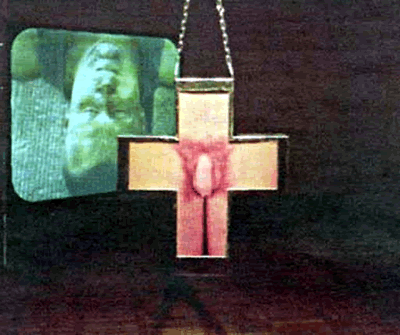
Confronting Bodies: Polish government, religious groups in Poland
Date of Action: 1993, 1999, 2001, 2003
Specific Location: Poland
Description of Artwork: The first major case of Feminist Art being censored was Alicja Zebrowska's video installation "Original Sin". The film footage confronts the viewer with un-idealized sexuality. Female anatomy, sexuality, and religious views of women are commented on in this piece. The title itself draws the comparison between the religious view of women and the unidealized female anatomy. The footage includes close-ups of a vagina, a hand job, masturbation with a dildo, and medical irrigation of the vagina. The film was screened inside a room saturated with an apple aroma. It starts with the artist herself eating an apple and ends with a woman in labor giving birth to a Barbie doll--alluding to modern day Poland.
The second major case deals with artist Katarzyna Kozyra's photo-piece called "Blood Ties". It was intended to be exhibited publicly on billboards. "Blood Ties" consists of four square photographs. Each of the photos is of a naked woman, the artist herself or her sister who has an amputated leg. The backdrop is of a red cross or crescent. On the bottom two panels the cross and crescent are surrounded by either cabbages or cauliflowers. The billboards were meant to bring attention to the suffering women went through during the Kosovo War, especially during religious clashes. The cross and crescent symbolize the religious clashes as well as the relief organizations who provide aid to war victims. The women are posed to appear as casualties.
The third, and most severe case of censorship dealt with the work of Dorota Nieznalska. Her installation piece "Passion" was exhibited in 2001. The installation consists of a mute video in slow motion of a man lifting weights and a pendant cross hung nearby covered with a photograph of male genitals. Unlike the other two artists Nieznalska deals with masculinity and the masochistic male suffering in order to gain strength.
Description of Incident: When the first piece, Zebrowska's "Orginal Sin", was exhibited in 1993 there was an outcry of opposition. In 1993 a concordat between the Vatican and the Polish government helped to further weaken the separation between church and state. In addition, a very restrictive anti-abortion bill was passed that year. Because of the political climate at the time Zebrowska's piece was not shown in any state-owned art institutions.
In 1999 Katarzyna Kozyra's piece "Blood Ties" was scheduled to be shown on billboards in Poland. The media soon became aware of what was about to be exhibited and began contacting Catholic organizations and municipal governments to see if they would object to the piece. This became a call to arms and the artist was forced to blue-pencil the nude women so that the cross and the crescent became indecipherable. Only the panels with the cabbages and cauliflower were allowed to be shown. The objection to the piece was that the photographs made unholy use of religious images--that the nude women profaned the cross and crescent.
With Dorota Nieznalska's piece "Passion", the media again helped ignite controversy. Snippets of the piece were shown on television and members of the right-wing League of Polish Families saw the clip, lodged a complaint on religious grounds and mounted a campaign against the piece. Activists raided the gallery where her work was being shown and the All-Polish Youth, the League of Polish Families' skinhead militia, threatened to shave Nieznalska's head (as was done with women who were believed to have had relations with Nazis). The League of Polish Families then sued the artist, asserting the article 196 of the Criminal Code was violated. This article said that offending religious feelings through public misrepresentation of an object or place of worship is liable to a fine or a maximum two year prison sentence. In 2003 the court found her guilty and ordered her to a 6 month "restriction of freedom", ordered her to do community service work, and to pay all trial expenses. The artist is now appealing to have the sentence overturned on free speech grounds.
Results of Incident: Many believe that the censorship of these women's art shows the need for Poland to open up and progress. In 2004 Poland joined the European Union, and many felt that perhaps this would lead to progress. However, Poland continues to cling to its religious patriarchy.
Source: Article "Feminist Revolt: Censorship of Women's Art In Poland" by Pawel Leszkowicz, published in Bad Subjects http://bad.eserver.org/reviews/2005/leskowicz.html
Submitted By: NCAC